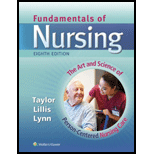
Concept explainers
To discuss:
The communication skills needed by the nursing student to improve to ensure to function as member of the patient care team and obtain assistance when needed?
Case summary:
The nursing student is caring for a 17-year-old female patient Ms. W, who just arrived back to the United States after visiting her family in China. The patient got flu like symptoms and arrived in the emergency department. The patient had a fear of getting herself infected with the flu virus as she had read about the virus in newspapers and these viruses are currently spreading in Asia. The patient is trying to convince her by asking the student nurse that she only got some cold and not infected by the virus.
To discuss:
How might the transmission of the infection might be prevented?
Case summary:
The nursing student is caring for a 17-year-old female patient Ms. W, who just arrived back to the United States after visiting her family in China. The patient got flu like symptoms and arrived in the emergency department. The patient had a fear of getting herself infected with the flu virus as she had read about the virus in newspapers and these viruses are currently spreading in Asia. The patient is trying to convince her by asking the student nurse that she only got some cold and not infected by the virus.
Want to see the full answer?
Check out a sample textbook solution
- The importance of monitoring resident's wound healing (bed sores, cuts, and scrapes, etc.) and how can a nutritionist utilize this in their career? Please not just a short explanation.arrow_forwardThe importance of seeing how it is to work as a chief in a nursing home and how they accommodate for special diets (low sodium, low sugar, heart healthy, etc.) and how can a nutritionist utilize this in their career? Please not just a short explanation.arrow_forwardThe importance of dealing with work confrontation (different healthcare departments fighting; diet aide and CNA) as a manager of a kitchen and how can a nutritionist utilize this in their career? Please not just a short explanation.arrow_forward
- Question 1: You are the Community Dietitian for the local public health agency. Recent news coverage has highlighted the state of food insecurity and child hunger in your county. Initial reports indicate that 15% of the population is food insecure. Of this group, 28.4% are children. It is estimated that 86% of the food insecure population is eligible for federal nutrition assistance. You are asked to conduct a community needs assessment and, ultimately, develop an appropriate intervention aimed at reducing hunger. First, however, you must submit a plan for the needs assessment. Complete the following: 1. State the nutritional problem (10 pts) 2. Set the parameters of the assessment (20 pts, 5 pts per bullet) A. State the purpose of the assessment B. Identify the community and target population for this assessment C. Develop 2 goals and 2 SMART objectives for each goal D. Discuss the major categories of community data and target population data E. Specify the types of data you might…arrow_forwardAssignment Instructions: Nursing Research Essay Objective: Select a specific area of nursing that captivates your interest. Compose a comprehensive essay, ranging from 300 to 500 words, that delves into the intricacies of nursing research within your chosen area. It is recommended that you consider the topic carefully as this topic, should be the topic for your course research project: see week 4 assignments. Your essay should elucidate the following points: The Significance of Nursing Research: Explore how nursing research in your selected area contributes to advancements in applied medicine. Discuss the potential achievements and innovations that can arise from dedicated nursing research in this field. Articulate the value and impact of such research on patient care, healthcare practices, and overall medical knowledge. Research Methods and Approaches: Identify the most effective methods for conducting nursing research in your chosen area. Highlight specific topics or research…arrow_forwardThe importance of understanding low meal consumption of residents in a nursing home and how can a nutritionist utilize this in their career? Please not just a short explanation.arrow_forward
 Phlebotomy EssentialsNursingISBN:9781451194524Author:Ruth McCall, Cathee M. Tankersley MT(ASCP)Publisher:JONES+BARTLETT PUBLISHERS, INC.
Phlebotomy EssentialsNursingISBN:9781451194524Author:Ruth McCall, Cathee M. Tankersley MT(ASCP)Publisher:JONES+BARTLETT PUBLISHERS, INC. Gould's Pathophysiology for the Health Profession...NursingISBN:9780323414425Author:Robert J Hubert BSPublisher:Saunders
Gould's Pathophysiology for the Health Profession...NursingISBN:9780323414425Author:Robert J Hubert BSPublisher:Saunders Fundamentals Of NursingNursingISBN:9781496362179Author:Taylor, Carol (carol R.), LYNN, Pamela (pamela Barbara), Bartlett, Jennifer L.Publisher:Wolters Kluwer,
Fundamentals Of NursingNursingISBN:9781496362179Author:Taylor, Carol (carol R.), LYNN, Pamela (pamela Barbara), Bartlett, Jennifer L.Publisher:Wolters Kluwer, Fundamentals of Nursing, 9eNursingISBN:9780323327404Author:Patricia A. Potter RN MSN PhD FAAN, Anne Griffin Perry RN EdD FAAN, Patricia Stockert RN BSN MS PhD, Amy Hall RN BSN MS PhD CNEPublisher:Elsevier Science
Fundamentals of Nursing, 9eNursingISBN:9780323327404Author:Patricia A. Potter RN MSN PhD FAAN, Anne Griffin Perry RN EdD FAAN, Patricia Stockert RN BSN MS PhD, Amy Hall RN BSN MS PhD CNEPublisher:Elsevier Science Study Guide for Gould's Pathophysiology for the H...NursingISBN:9780323414142Author:Hubert BS, Robert J; VanMeter PhD, Karin C.Publisher:Saunders
Study Guide for Gould's Pathophysiology for the H...NursingISBN:9780323414142Author:Hubert BS, Robert J; VanMeter PhD, Karin C.Publisher:Saunders Issues and Ethics in the Helping Professions (Min...NursingISBN:9781337406291Author:Gerald Corey, Marianne Schneider Corey, Cindy CoreyPublisher:Cengage Learning
Issues and Ethics in the Helping Professions (Min...NursingISBN:9781337406291Author:Gerald Corey, Marianne Schneider Corey, Cindy CoreyPublisher:Cengage Learning





